Ute comparison: Ford Ranger v Holden Colorado v Isuzu D-Max v Mazda BT-50 v Mitsubishi Triton v Nissan Navara v Toyota HiLux v Volkswagen Amarok
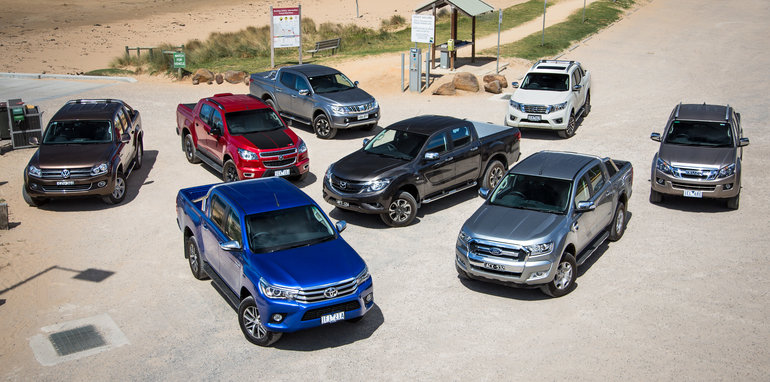
Utes, pick-ups, trucks, dual-cabs, double-cabs â€" whatever you call them, these big four-door 4×4 haulers are massively important to buyers in Australia.
The 4×4 utility segment has boomed in recent years, and it remains one of the strongest parts of the Australian new car market â€" indeed, roughly one in every 10 vehicles sold in this country will be a four-wheel-drive commercial vehicle.
But the fact is that these vehicles are now performing dual roles â€" they are often driven as business vehicles during the week and then turned around as family run-arounds on the weekend.
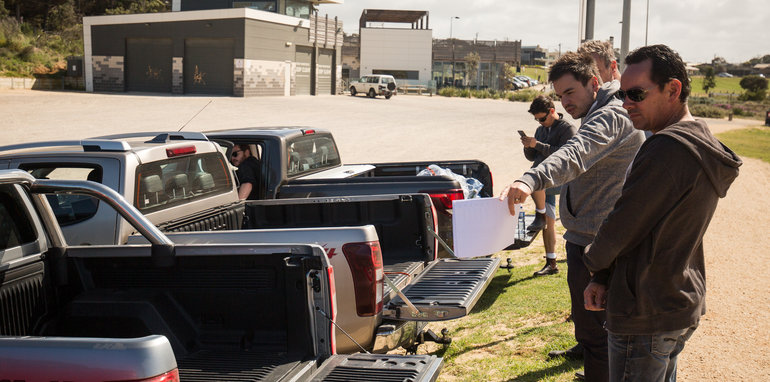
It would be reasonable, then, to expect that these trucks would need to be more sophisticated, refined and comfortable than ever before, as well as safer, smarter and still rugged enough to cope with the rigours and drudgeries of day-to-day work.
As such, we’ve assembled the eight best-selling vehicles in this segment to see which is the best dual-purpose vehicle.
The latest addition to the market is perhaps the most important â€" the Toyota HiLux. This is the truck that thoroughly impressed me at the Australian launch because of how much better it was than the old best-selling model that has topped the ute sales charts â€" and the commercial vehicle sales numbers â€" for the past 17 years straight. It will be very interesting to see how it stacks up against its rivals.
The model that is closest to the HiLux on the sales charts, the just-updated Ford Ranger, has impressed CarAdvice with its road manners, comfort, technology and safety gear. It’s the first ute on the market available with (optional) adaptive cruise control, lane departure warning and lane-keeping assistance.
Another game-changer in the market is the Nissan Navara, which has a unique five-link coil spring rear suspension set-up that sets it apart from its leaf-sprung compatriots.
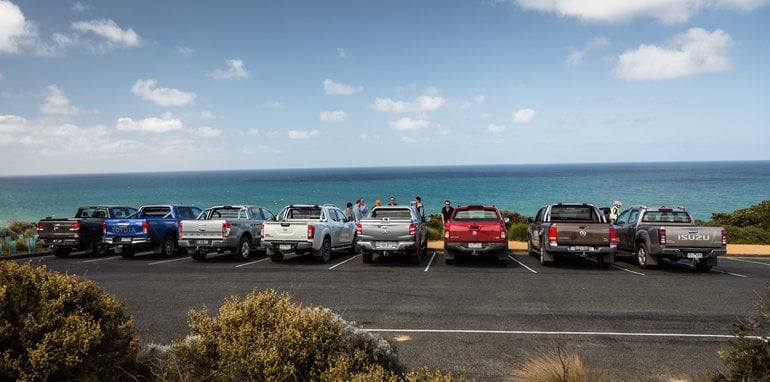
The highly popular and budget-friendly Mitsubishi Triton is here after making its debut in fifth-generation guise earlier in 2014.
We’ve also got the grunty Holden Colorado, the polished Volkswagen Amarok, work-focused Isuzu D-Max, and the now more-masculine Mazda BT-50.
This mega-test debuts our new formula for scoring, which sees all these utes put through a gamut of five different measurable criteria.
They are: ownership and value; drivetrain; on- and off-road; load and towing (where we put 650kg in the tray with two adults on board, and then put a loaded box-trailer â€" 750kg combined mass â€" with four adults on board); and the interior, because it’s probably one of the most important facets of a dual-cab, dual-purpose rig.
And because not all decisions are made rationally we’ve added an additional criterion for the judges’ pick, which allows our four experienced road testers (myself, Trent Nikolic, Curt Dupriez and Mike Costello) to assess each vehicle against each criterion and then choose the one they’d drive home.
How do we arrive at a verdict? Each judge is tasked with ranking every ute â€" scoring them from one for worst through to eight for best â€" for categories that are subjectively judged. Then we simply add the judges’ rankings (again, one to eight) together to sort category pecking order, again highest score wins, lowest gets the wooden spoon.
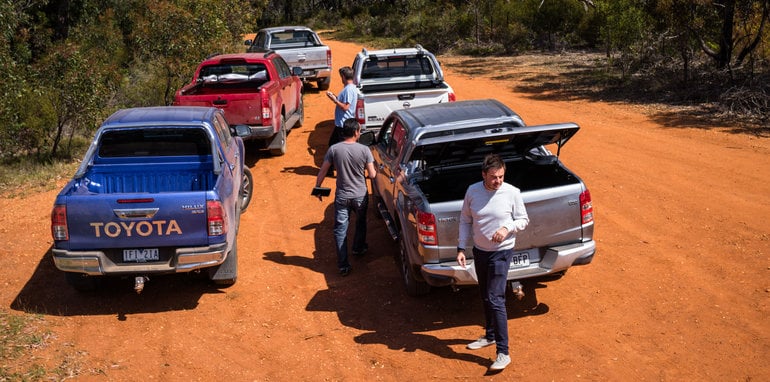
For objective categories, such as load capacity in this ute test, the competitors get ranked by their relative performance. Simple. Â
Let’s get in to it.
Ownership and value
We selected a range of models that compete fairly closely on price. All are diesel, auto, 4×4, dual-cab, pick-up body style utes, and all are either top- or second-from-top-spec. Here’s a list of how they stack up, from most affordable to most expensive (not including on-road costs):
- Mitsubishi Triton Exceed, $47,490
- Mazda BT-50 XT, $51,700
- Isuzu D-Max LS Terrain, $53,000
- Nissan Navara ST-X, $54,490
- Volkswagen Amarok Highline, $55,490
- Toyota HiLux SR5, $55,990
- Ford Ranger XLT, $56,690
- Holden Colorado Z71, $57,190
So, the least expensive is almost 10 grand more affordable than the dearest. It’s a fair split, we’ll admit, but it certainly helps shake things out in terms of which offers the best value for money.
And the top-spec Triton, unquestionably, nails that brief.
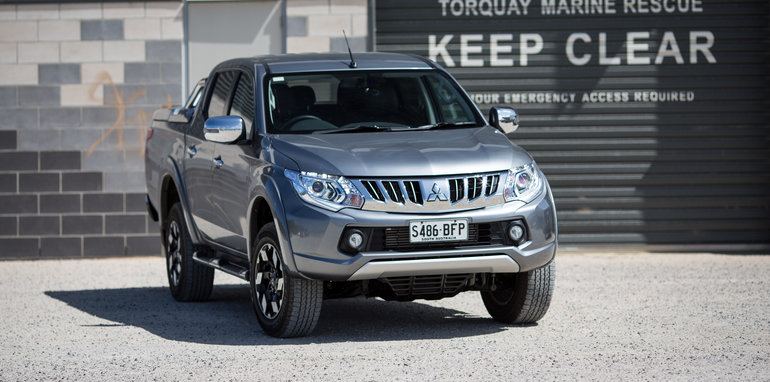
It misses out on nothing that the rest of these utes come with as standard, including dual-zone climate control (which the HiLux, Colorado and D-Max miss out on, each having single-zone), satellite navigation (which the Colorado misses out on â€" you have to download an app to your phone) and a reverse-view camera (which the Ranger misses out on in XLT guise â€" it’s optional as part of that aforementioned safety pack, for $1100). It’s also the only one here with side mirrors that fold away when you lock it.
It is worth noting that our Triton had a couple of options, including the hard lid with integrated LED light, and a tub-liner.
A hard-wearing tub trim is standard only on the Ranger and the Navara, though the D-Max and Amarok also had them fitted on test.
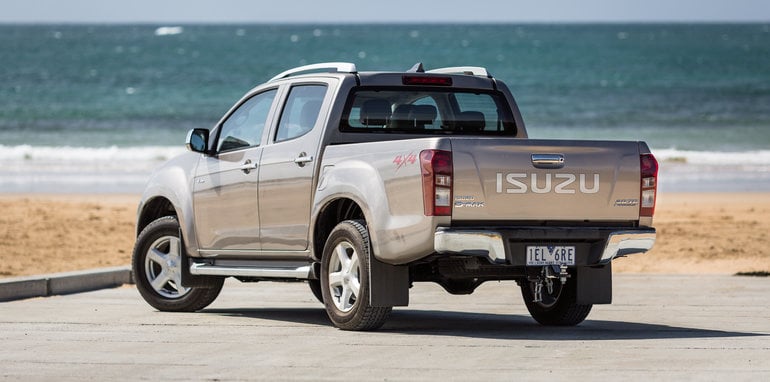
All bar the D-Max had sports bars fitted as standard, with the Amarok and Ranger taking their usefulness to the next level with lighting for their respective tubs. The Colorado Z71 has a “sailplaneâ€-style plastic sports bar, while the rest are chrome, and the Colorado is the only one with a tonneau cover as standard. It’s worth noting that this broke during our test, and the previous Z71 we’d tested had a broken one, too…
While the Triton is a budget-friendly buy, the Nissan is also very well kitted for the price.
It has a few inclusions that the rest miss out on, including a sunroof (which, disappointingly, eats into headspace front and rear) and rear seat air-vents.
It, along with the HiLux and D-Max, also has keyless entry and push-button start, and the Navara and HiLux both get LED headlights, too.
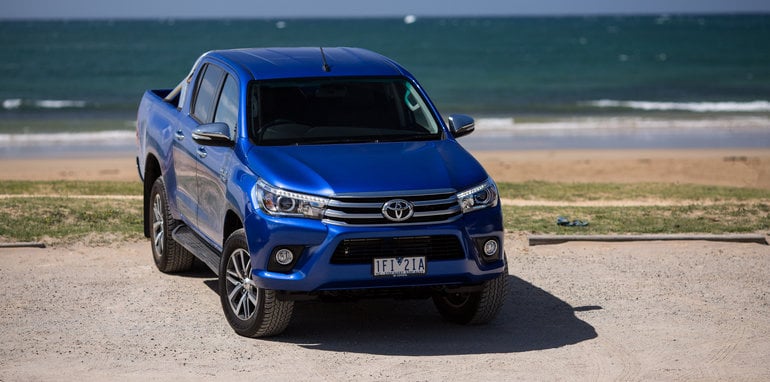
The Navara, Triton, D-Max and Colorado all have leather (or bo-vinyl, more likely) interior trim, and the Colorado and Navara were the only utes set up for cooler climates, with seat heating standard. The Amarok has the option of seat heating ($590), while our HiLux â€" which can’t be had with bum warmers â€" had the optional SR5+ pack with leather and electric seat adjustment that adds $2000 to the price.
And while many buyers will pull the stock alloy wheels off and fit some upsized rims to their truck, the Navara, HiLux and Colorado come standard with 18s in the specifications tested. The Amarok, BT-50, D-Max, Triton and Ranger all have 17s.
For those who venture far and wide, consider that the Amarok, Triton, Navara, Hilux, D-Max and Colorado come with full-size alloy spare wheels in the tested spec. The BT-50 comes with a temporary spare only.
And while seven of the vehicles on test had tow kits fitted as options, it is worth noting that the Ford is the only one to come with a tow bar as standard. Nice one, Blue Oval dudes.
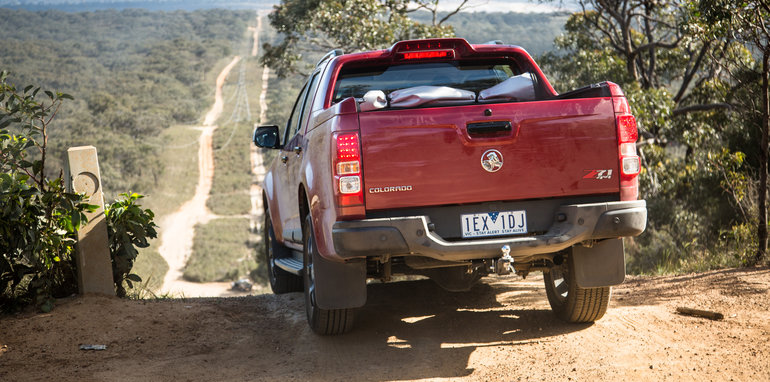
When it comes to interior hardware (and software), it’s kind of awesome to say that every ute in this test has a touchscreen media system. But that could be an issue for buyers who use their ute for work as well as play, particularly painters and plumbers.
As we’ve already mentioned, the Holden misses out on in-built satellite navigation, but you can use an app that is purchasable for smartphones that hooks up through Bluetooth. All utes have that phone-link technology with telephony and audio streaming, too.
That said, the Amarok is the only vehicle here without a USB input â€" though that is set to change in line with a 2016 model year update, along with the Highline’s touchscreen media system which could see a higher-resolution screen, better reverse-view camera, and the addition of Apple CarPlay and Android Auto, which will likely be the first in the ute segment. But the Volkswagen hasn’t got any of that yet, and as such it seems a bit overpriced.
In terms of screen sizes, the Amarok’s is the smallest (5.0-inch). The Colorado, Navara, HiLux, Triton and D-Max all have 7.0-inch screens, while the BT-50 has a new 7.8-inch unit and the Ford â€" with its impressive Sync 2 interface â€" is formatted at an impressive 8.0-inch size.
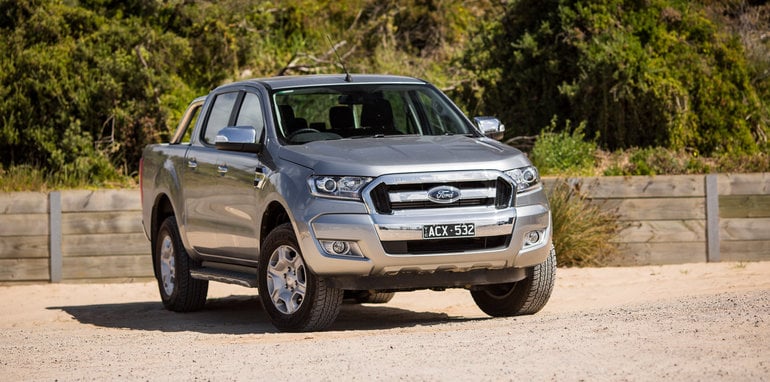
We had a few clashes over which was the best to use â€" I liked the screen in the Toyota, while Mike wasn’t a fan. Trent liked the system in the Isuzu, Curt said he didn’t mind the Holden’s screen, but all of us agreed that the aftermarket system fitted to the Mazda was slow to load up (it needs more processing power), and that the system in the Mitsubishi was the worst for usability and intuition.
All of these utes â€" except the Ford, as mentioned â€" come with a reverse-view camera as standard, though the quality and execution of the technology varied greatly between utes. Further, the Amarok, Navara, Ranger and Colorado all have standard rear parking sensors, too.
Mike took the lead to assess these and he found the Ford â€" though optional ($600 on its own or $1100 with the driver assist tech) â€" was easily the best in terms of clarity of display, and it also has coloured guidelines to help you line up when reversing (as did the Mazda and Nissan). The Navara was the second-best overall, with a clear display and centred camera.
Surprisingly, the BT-50 â€" which rocks a new media screen â€" has its camera fitted in the rear-view mirror, and it is quite small and hard to see at times. But it offered a good view of the tow ball and was of a decent resolution.
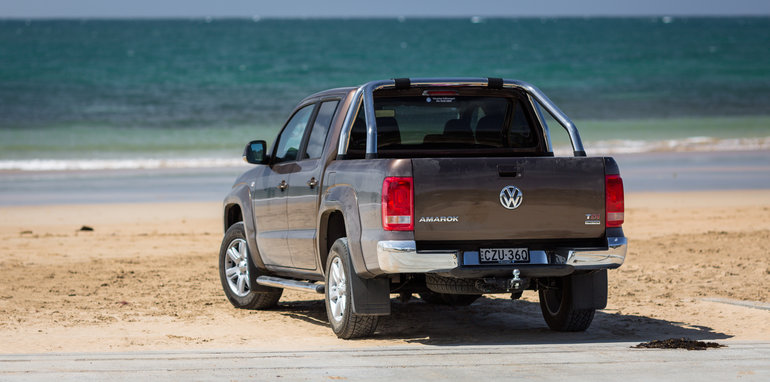
The Triton and HiLux both had offset cameras, so the tow ball was not centre of the screen â€" which is a bit annoying when trying to line up a trailer.Â
The D-Max, despite its larger screen, had worse resolution than almost all the others. The Colorado was also on the poor side, with a low-res display and a grainy resolution, but the towball was easy to see despite appearing tiny.
The Amarok was considered the worst overall. The screen was small, the resolution grainy, and depth perception was more difficult as a result.
So, the Triton is clearly the best value as an outright purchase here, and it has strong ownership prospects, too.
The Triton and D-Max both share the longest warranty coverage of five years/130,000 kilometres. The rest have three years and either 100,000km (Colorado, HiLux, Navara, Ranger) or unlimited kilometres (Amarok, BT-50).
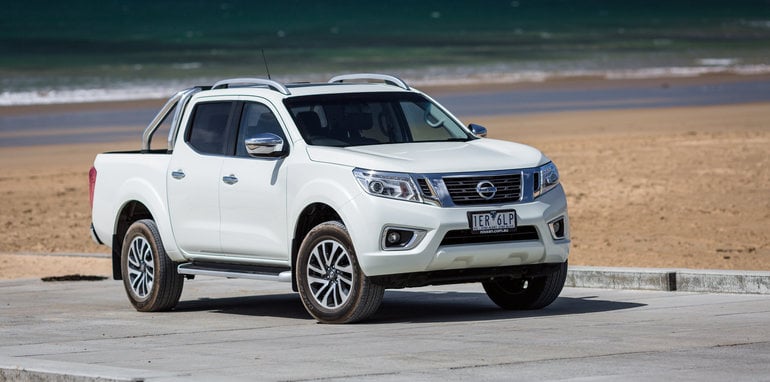
It’s worth noting that the D-Max and HiLux require more frequent servicing (six months or 10,000km) and the BT-50 needs servicing every 12 months or 10,000km. The Amarok, Colorado, Ranger and Triton require maintenance visits every 12 months or 15,000km.
For the long-distance drivers, the Navara could hold some extra appeal, with services due every year or 20,000km. The BT-50 will likely lose some appeal if you a lot of mileage, as it needs maintenance more often in terms of kilometres covered.
In terms of service costs, all vehicles here have fixed-price maintenance programs of three years (D-Max, HiLux), four years (Triton), six years (Amarok, Navara) or the life of the ute (BT-50, Colorado and Ranger).
In terms of average annual costs there’s a clear loser. The D-Max is the dearest at $758 because it needs servicing twice per year, while the HiLux â€" which also needs two dealership visits per calendar â€" is the cheapest at $360 per annum.
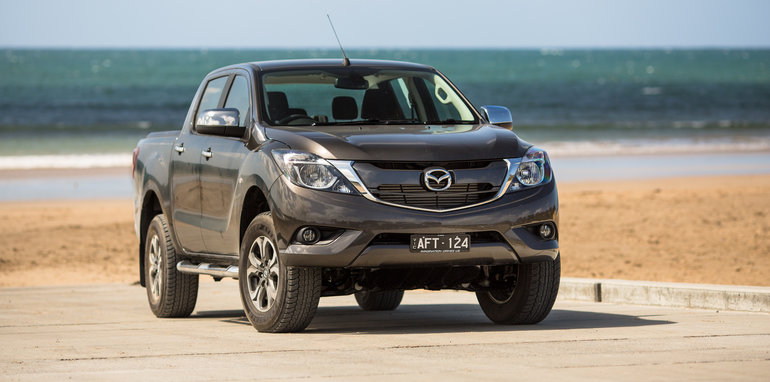
The Navara is a on the pricey side at $599 per annum, followed by the Amarok ($537), the Triton ($522), the Ranger ($506), the BT-50 ($463.50), and the Colorado, which, at $369 pear year, just falls short of being the best for service costs.
Powertrain
There are some brands that don’t even offer petrol engines in their utes any more, such is the popularity of diesel. You get better low-end pulling power, better economy and, generally, a more robust, long-lasting engine.
As such, all of our utes were powered by turbo-diesel engines, and every ute on test had an automatic transmission, because that’s what the majority of buyers who choose a ute as a dual-purpose vehicle tend towards these days.
But the specifics in terms of cylinder count and forward ratios varied dramatically, and while the majority of them offer single-turbo engines, the Volkswagen and Nissan both have twin-turbo technology that is designed to get more out of a smaller capacity engine by spreading the load across a wider rev range.
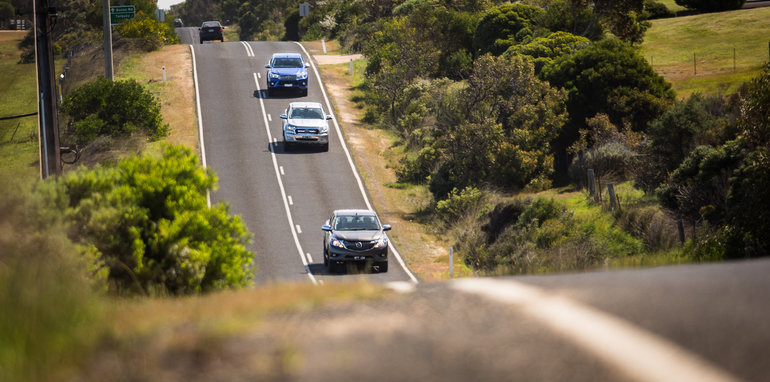
The largest engines were those in the Ford Ranger and Mazda BT-50, which are 3.2-litre five-cylinder powerplants. Both have identical power (147kW at 3000rpm) and torque (470Nm at 1750-2500rpm), but the Ford’s recent update saw changes to the throttle calibration. Both have six-speed auto transmissions with identical gearing.
The remainder of the engines on test were four-cylinder units, but they varied in capacity and in terms of the forced-induction strategy.
For example, the D-Max has the largest four-cylinder engine in terms of capacity, with its 3.0-litre unit offering â€" oddly â€" the equal-least amount of power (130kW at 3600rpm) and the least torque (380Nm from 1800-2800rpm), and the D-Max has the least number of forward ratios (five). This is an engine that has been around for a while, and the figures reflect it.
The next biggest in terms of capacity is the Colorado, which does a lot more with its 2.8 litres. In fact, it equals the extra-cylindered Ford and Mazda with 147kW of power (at 3600rpm) and has the most torque of any ute here, with 500Nm at 2000rpm. It has a six-speed automatic.
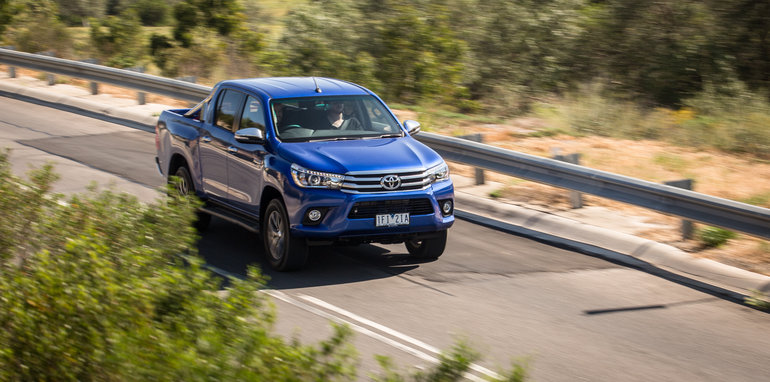
Also with a 2.8-litre four-cylinder is the HiLux. This all-new engine is also fitted to Toyota’s Prado and Fortuner, but â€" on paper at least â€" it comes across as a little lazy with the equal-lowest 130kW of power (at 3400rpm) and 450Nm of torque (at 1600-2400rpm). It has a new six-speed auto, too.
The next down the size line was the Triton’s 2.4-litre four-cylinder, with 133kW of power (at 3500rpm) and 430Nm of torque (at 2500rpm). It has a five-speed auto.
Then come the twin-turbo Euros. Well, sort of.
The Navara’s 2.3-litre unit is a product of the Renault-Nissan Alliance, and despite being the second-smallest engine here it produces 140kW of power (at 3750rpm) and 450Nm of torque (at 1500-2500rpm). It is mated to a seven-speed auto.
The smallest engine of all the utes here is the Volkswagen’s twin-turbo 2.0-litre unit, which has 132kW of power (at 4000rpm) and 420Nm of torque (at 1750rpm). As well has having the smallest capacity, it has the most gears in its transmission: eight.
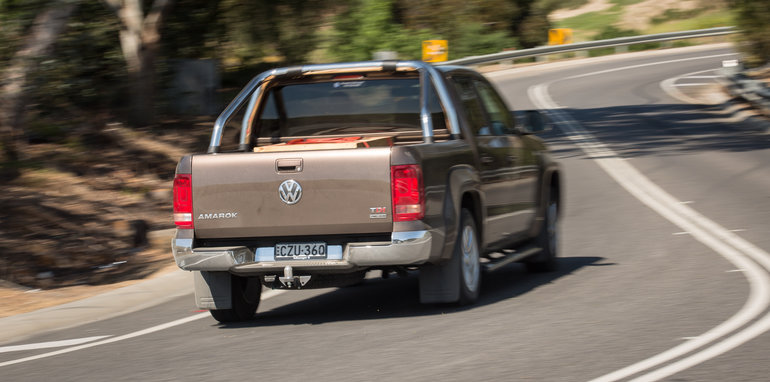
As you can probably tell by the fact the Amarok’s peak power hits at a higher point than any of the other utes here, it doesn’t mind exploring the rev range. And that’s totally fine, because it does so with linearity and refinement.
With a 650kg load in the tray the Amarok’s engine felt a little more stressed than its competitors, but not enough to make you think twice about its capability. The wider spread of gear ratios means the engine can spread the work to ensure it’s hitting the sweet spot, and the gearshifts are smooth.
The vehicle that felt the least troubled by the load was the Ranger, thanks to its excellent engine and transmission combo that was described as “effortlessâ€, “train-like†and “properly quickâ€.
Indeed, we did our own performance testing (without a load on board), and found the Ford was easily the fastest from 0-100km/h, with an 11.1-second sprint. Next was the Navara (11.3sec), D-Max and Colorado (11.8sec), Amarok (12.2sec), Triton and BT-50 (12.4sec) and the slowest â€" by some measure â€" was the HiLux (13.5sec).
The Ranger, then, took our top spot in terms of engine performance, while the other one that impressed us all with its urge was the Navara.
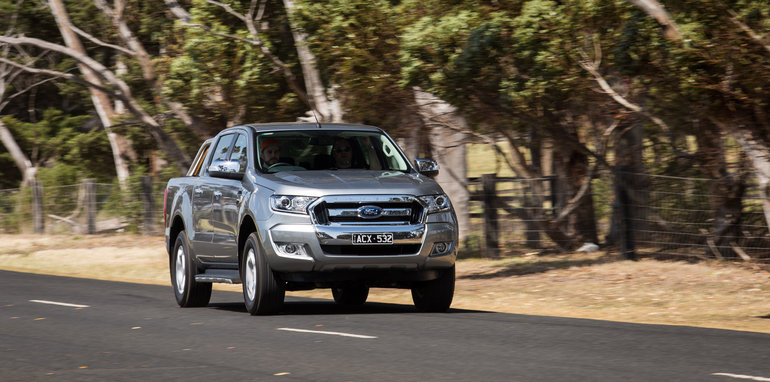
This feels like an engine with two different personalities. Around town under light throttle it’s a bit noisy, whiny and not overly pushy, but if you push harder on the right pedal it pulls with plenty of force from 2000-3000rpm. Mike said he found it to be a “really, really good engine with lots of punchâ€, while the seven-speed auto “did its job and was unobtrusiveâ€. Â
The engine that caught us by surprise was the big, old 3.0 litre in the D-Max, and not just because it was the loudest engine at highway speed (72.8dB; compared to the quietest, the Amarok: 66.8dB). For those who spend more time around town, the Triton was the quietest at 60km/h, registering a 61.3dB readout, while the HiLux was found to be loudest at that speed, reading 70dB â€" oddly enough, all judges found it to be pleasantly quiet and refined in the suburbs.
The D-Max’s engine had brilliantly linear power delivery, and with a load on board it felt “completely unfazedâ€. It is a willing drivetrain and the gearbox shifted cleverly and never mucked about. “It feels like a proper little truck,†said Curt.
All judges thought it was strange how the powertrains of the BT-50 and Ranger felt quite different, given that they both have the same engine and transmission with the same ratios. And despite the fact the Ranger is heavier (2229kg versus the BT-50 at 2105kg) it felt more sprightly thanks to its lively throttle response.
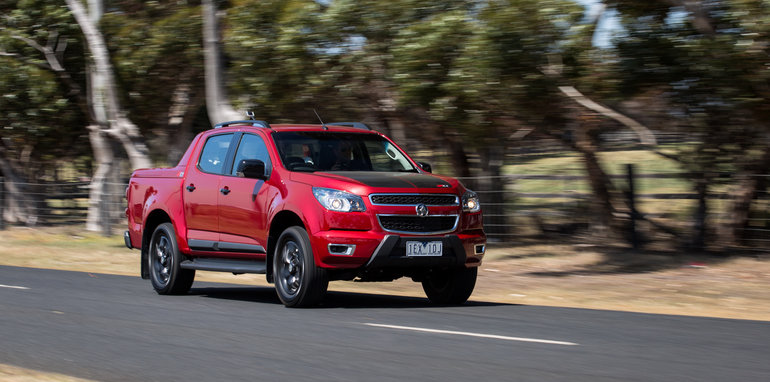
At higher speeds the Ranger felt more settled, though, not holding its gears as long as the BT-50. All judges commented on how strange this seemed given the overwhelming similarities, and all felt the touchiness of the Ranger’s throttle could be a pain around town, while the gear-holding nature of the BT-50 was also a bit frustrating. It had the same characteristics both loaded and unloaded.
Our judges commended the Triton for its “unstressed†nature, given its relatively small output. Trent said he stood by his earlier review where he stated that it was “a lot more refined, smooth and quiet than beforeâ€, but admitted it wasn’t the powerhouse that some of the others in this field were. All judges were impressed by the refinement, general quietness and clever gearshifts of the Triton.
Likewise impressive was the HiLux’s new 2.8-litre engine that felt “unflappable†whether there was a load on board or not. There was hardly any noticeable difference in performance â€" it was still fairly quiet and nicely refined, and Curt said he thought “it was pretty energetic and I really liked the linearityâ€. That linearity partly came down to the transmission knowing what was needed of it, although Mike said he experienced a couple of sharp downshifts.
If there was a letdown in the engine stakes, it was the Colorado. Judges found it to be “noisy†and “laggy†when unladen, if with good pulling power through the mid-range. With a load on board it was found to be “strainedâ€, with the gearbox holding on to cogs for seemingly ages and the engine flaring during shifts. “Something has to come last, but I don’t see how I can put it ahead of D-Max or Triton,†Trent said.
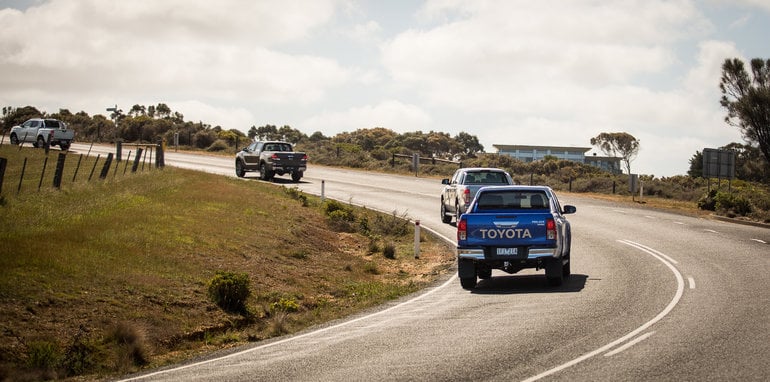
Fuel use was another important consideration for our judges, and there were a few surprises.
Below is our list of utes, ranked lowest to highest in terms of claimed consumption, and the second column shows the actual consumption on test, while the third column is the percentage higher or lower than the claim these results put each ute:
| Ute | Claimed | Actual | Variance |
|---|---|---|---|
| Navara | 7.0L/100km | 8.8L/100km | 26 per cent over |
| Triton | 7.6L/100km | 8.2L/100km | 8 per cent over |
| D-Max | 8.1L/100km | 10.9L/100km | 35 per cent over |
| Amarok | 8.3L/100km | 8.2L/100km | 1 per cent under |
| HiLux | 8.5L/100km | 11.7L/100km | 38 per cent over |
| Ranger | 9.0L/100km | 9.9L/100km | 10 per cent over |
| BT-50 | 9.2L/100km | 11.5L/100km | 25 per cent over |
| Colorado | 9.7L/100km | 10.4L/100km | 7 per cent over |
It’s clear the VW was the best here for fuel use, while the HiLux was terrible. It is worth noting that our HiLux had been on the recent local launch, and had the lowest number of kilometres on its clock, so it may not have been completely run in.
On- and off-road
Let’s focus on the on-road bit first. This is where the vast majority of buyers will spend the vast majority of their time. There are a few focal points here: ride comfort (which is often hard to come by in a ute); steering response at speed and around town (because who wants to work hard at the wheel after a hard day’s work?) and park-ability.
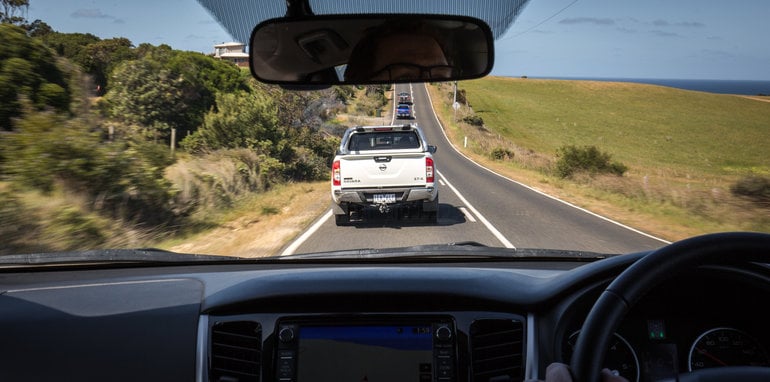
There were some shining lights here, both in the urban environment and on the open road.
The Ford Ranger won over almost everyone with its ride compliance over speed humps and sharp edges around town, while on the open road its soft feeling suspension meant it was a comfortable tourer for those weekend warriors out there, particularly over some rubbish country road surfaces. Mike made a great point when he said that the Ranger had the “best ride because it isn’t an issue â€" unlike most of the other utes hereâ€.
The biggest advantage the Ranger had over its compatriots, though, was its steering. The new electric-assist steering system fitted to the updated Ranger makes light work of slow-speed turning, which means in traffic, through roundabouts and during parking manoeuvres it is easy to pilot. But there is a lack of feel to that system, too.
The second top for comfort and drivability was the Volkswagen Amarok, which was found to have a slightly busier and firmer ride at lower speeds but rounded off bumps “pretty wellâ€.
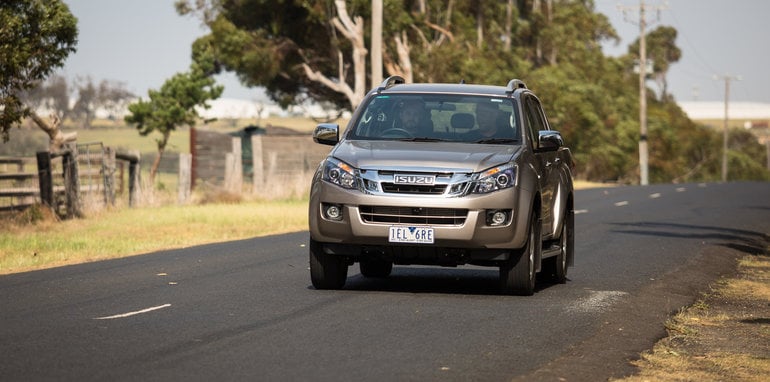
The steering of the Amarok is a little heavier at low speeds, but it does have an accuracy that the Ranger can’t match, and in that regard it is certainly more car-like to drive. Parking isn’t overly difficult, either.
Other decent performers on-road included the Navara, with its coil-spring rear end convincing Trent in terms of ride comfort, but he said its slow, dull, heavy steering really was “rubbishâ€, and that it “detracted from all the other improvements made to the new Navaraâ€. All judges agreed, and it was also pointed out that the front suspension of the Nissan could stumble over some bumps.
The BT-50 also suffered from a heavy, slow steering system at low speed that annoyed the judges, but above 20km/h â€" and up closer to 100km/h â€" it was a very pleasant steering system. CarAdvice CEO Andrew Beecher was along for the test, and he said the steering of the BT-50 felt “typically Mazda†with a “very natural and linear feelâ€. Indeed, all agreed that the BT-50’s high-speed steering was impressive.
The HiLux was a middle of the pack offering, with light and reasonably accurate steering making for easy slow-speed moves, while at speed it was also pleasant.
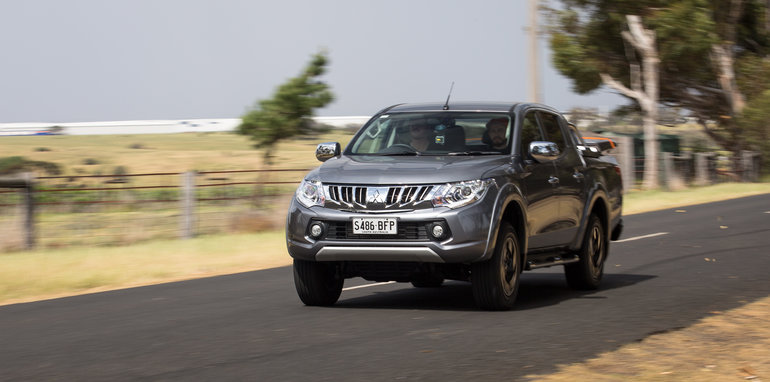
But it was bad news around town with an empty tray, as Mike succinctly put it: “it has the worst unladen ride and the lowest payload â€" it’s fine to be rubbish on road if you can handle 1500kg, but it can’tâ€, he said, referring to the HiLux’s poor payload. Curt concurred, claiming the “rear axle is just too fidgety and brittleâ€.
The D-Max was labelled “the prototypical workhorse†by Mike. Trent agreed that “it’s a typical uteâ€, in that “it will buck, jump and float, but it’s no worse than the HiLuxâ€.
Curt felt strongly about the drive experience of the Triton, which “has no compliance and would be pretty terribly to live with†while suffering from inconsistent steering at speed. “I would never subject my family to this car,†he said in reference its ride.
Mike concurred: “It feels like an old ute, constantly asking a lot of the driver.†I found the Triton was far more impressive at lower speeds, with a nice amount of steering feedback and response, and a good turning circle, too.
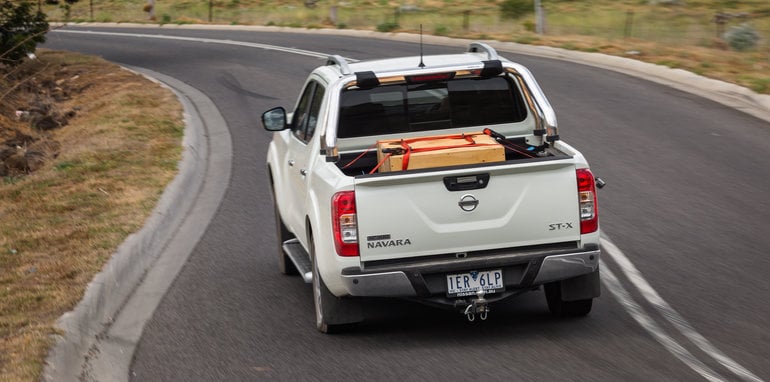
Last, and equally least, was the Colorado. Mike and I agreed that unlike the Ranger and Amarok, the Colorado “felt like a ute as opposed to a carâ€, with suspension that was “overly busy and overly jumpyâ€. The steering wasn’t great at high or low speeds, either.
Next, we traded the blacktop for some bush-bashing.
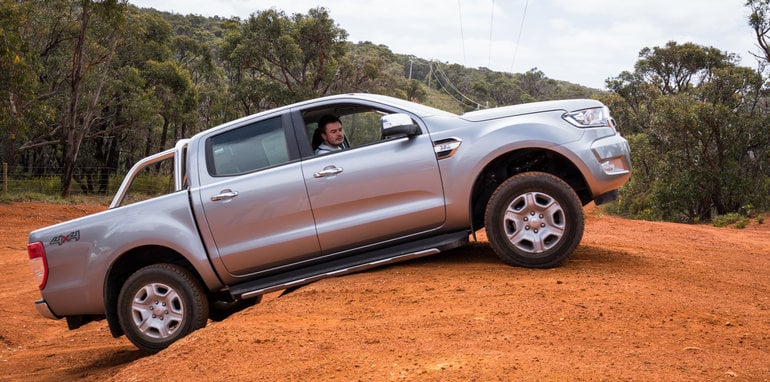
Off-road the Ranger once again impressed our judges. Trent said the “steering comes in to its own off-road, and if you’re going to do a lot of turns lock to lock, it may as well be lightâ€. As you can see, though, those side-steps do hang low.
The Amarok â€" being the only one here with a permanent four-wheel-drive system rather than a selectable gearing with low range â€" was thought to be surprisingly good at off-road work given its clear disadvantage. Curt put it this way: â€I know it doesn’t have low range, but it didn’t seem compromised by itâ€.
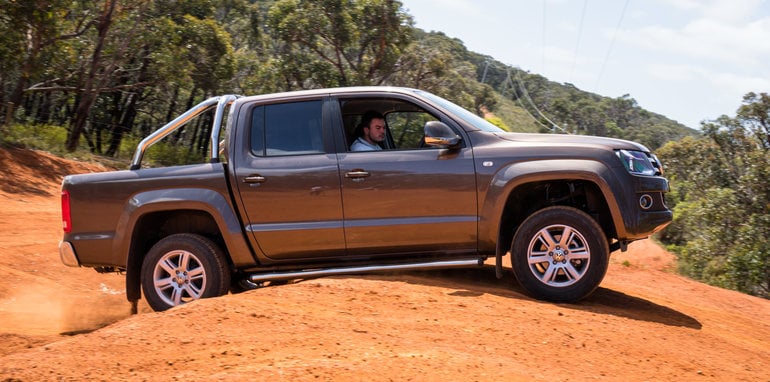
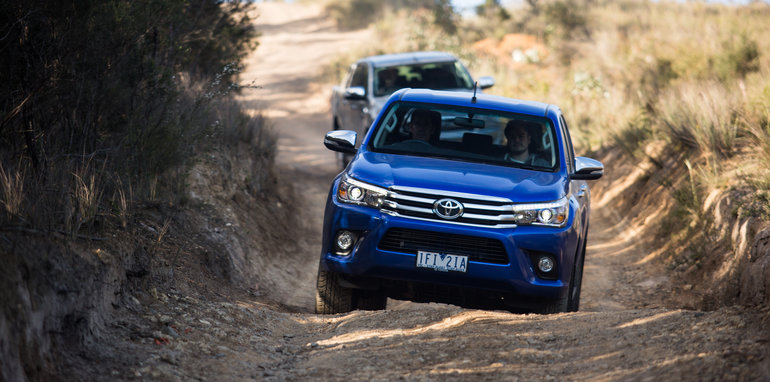
Mike, Trent and myself agreed. The Amarok is competent off road. It has an Off Road mode that primes the brakes and enables a permanent hill descent control system that means it will continually apply the brakes down gradients even when you don’t want it to, and a separate button would be welcome… But at least the Volkswagen has a hill descent mode for those who appreciate it, unlike the D-Max which was the only ute here without such a system.
But Trent made a great point â€" those silly low-hanging side steps would have to go for any serious off-roaders, as they compromised its break-over capability. “It has to get slugged off-road for ground clearance,†he said of the Amarok’s tight 192mm ride height.
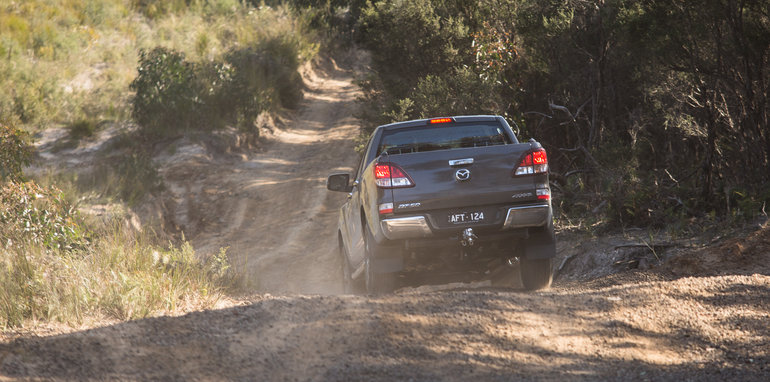
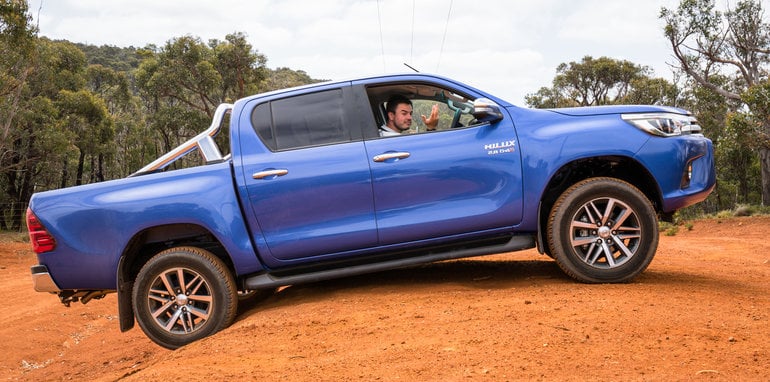
The HiLux has the best ground clearance of all the utes here, with 279mm at its disposal. And it proved the best in our break-over ramp test, as well as offering one of the best approach angles of 30 degrees (shared with Colorado and Triton), which is only bettered by the Navara â€" its bluff front-end allows an excellent approach angle of 32.4 degrees.
All eight vehicles struggled with their departure angles due to the fitment of towbars, but there were some that struggled more with rear-end clearance than others. The Triton â€" which already has the second-worst departure angle of 22 degrees (Ranger has the worst: 21deg) â€" touched down more prominently due to its low-mount towbar assembly.
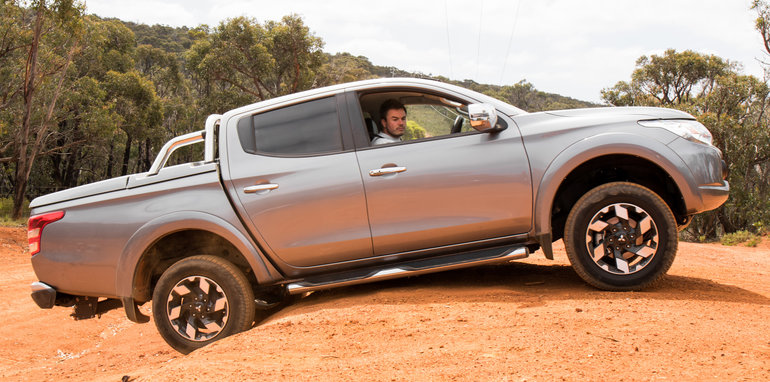
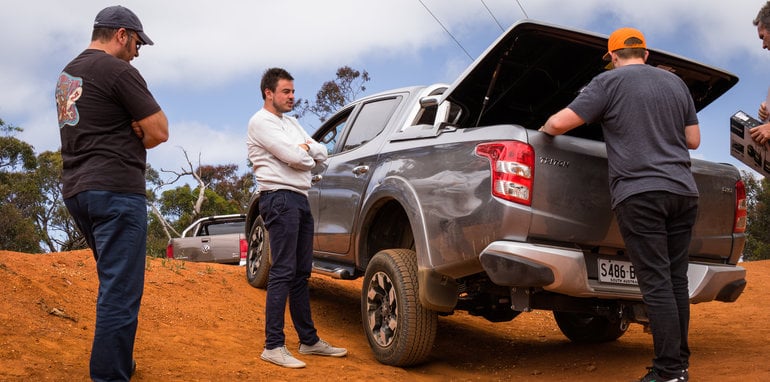
The Triton is built off the shortest wheelbase of all utes here (3000mm) and that also exacerbated the issue.
The HiLux felt one of the most competent off-road, and during a steep descent and ascent it never struggled for grip or traction. The hill descent control system proved excellent, too, not grabbing at the brakes as was the case in the Colorado.
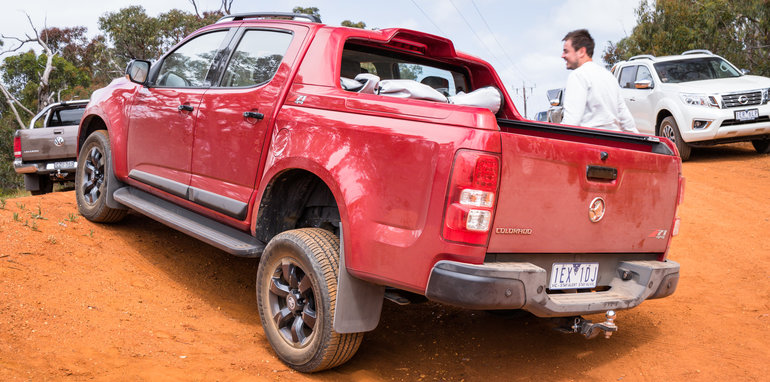
And while the D-Max lacked any trickery in terms of making its way down hill, its excellent low-range mode meant it crawled down hill without hassles anyway.
The BT-50 also performed comfortably off-road, with its slightly stiffer suspension still offering good articulation, and Trent found its low-speed steering offered a good amount of communication to the driver’s hands.
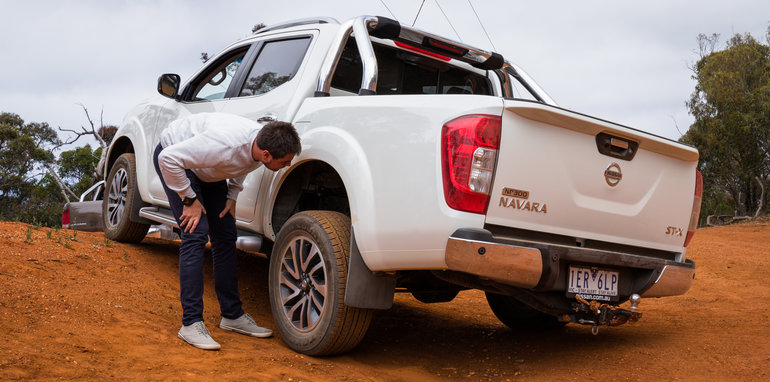
The Navara’s five-link rear suspension was praised for still offering very good articulation over bumps despite having a more complex suspension set-up. And its steering, which was more communicative at low speeds than many others, was also an advantage when trying to dodge divots and the like.
The Colorado ranked lowly for off-road as well as on-road manners. Trent stated that it felt “horrendous when it starts to run away from you with descent control onâ€, and all judges agreed felt it was the least composed in such scenarios, while it also felt less comfortable in terms of the suspension calibration. It had good articulation, though, and coped better with break-over situations than some of the other utes here thanks to good front suspension compression and rear-end droop that was better than many others.
Load and towing
Whether you use your ute for work or play, it pays to know what you can load or tow if you need to.
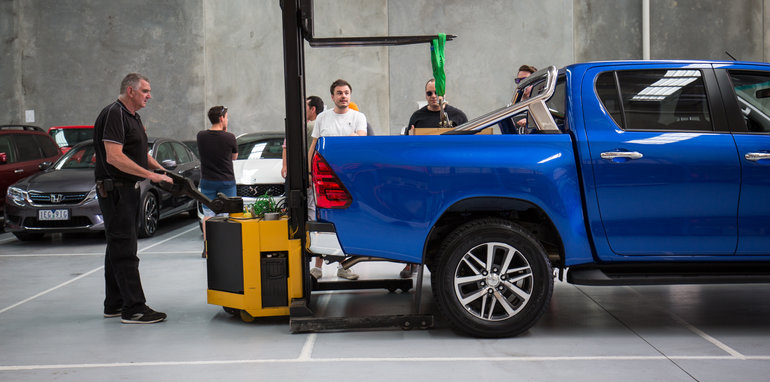
First, load spaces â€" and there’s a clear winner, in the form of the Volkswagen Amarok. It has the biggest tub here, and it’s the only one that can fit an 1165mm-square Aussie pallet between the wheel-arches. In fact, with the tailgate down, you can fit two.
The Amarok’s tray is the widest (1620mm) and one of the longest (1555mm), and in Highline spec it has a payload of 1000kg. That’s not the best here, though: that honour goes to the Mazda BT-50 that has a payload of 1095kg. The lowest is the Colorado, as the Z71 has ‘comfort suspension’, which seemingly doesn’t work very well.
Here’s a table to help you get your head around the differences, and we’ve included the Gross Combination Mass, which is how much you’re allowed to carry and tow at the same time.
| Ute | Tray length (mm) | Tray width/ between wheel-arches (mm) | Tray depth (mm) | Payload (kg) | Towing capacity braked (kg) | Gross Combination Mass (kg) |
|---|---|---|---|---|---|---|
| Amarok | 1555 | 1620 / 1222 | 508 | 1000 | 3000 | 5950 |
| BT-50 | 1549 | 1560 / 1139 | 513 | 1095 | 3500 | 6000 |
| Colorado | 1484 | 1560 / 1122 | 466 | 803 | 3500 | 6000 |
| D-Max | 1484 | 1534 / 1125 | 465 | 1010 | 3500 | 5950 |
| HiLux | 1569 | 1645 / 1109 | 481 | 925 | 3200 | 5650 |
| Navara | 1503 | 1560 / 1130 | 474 | 930 | 3500 | 5910 |
| Ranger | 1549 | 1485 / 1139 | 511 | 1065 | 3500 | 6000 |
| Triton | 1520 | 1470 / 1085 | 475 | 935 | 3100 | 5885 |
It is interesting, then, that the HiLux is incredibly comfortable with a load in the tray. We put 650kg of ballast in the back of each vehicle and had two occupants in the cabin every time, and the HiLux was one of the best on test for ride compliance and composure.
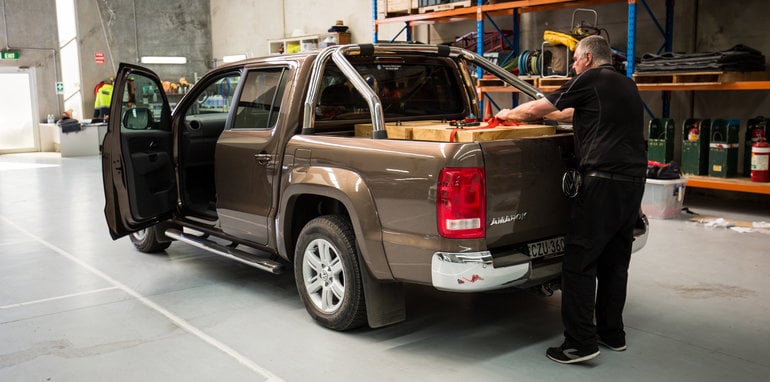
Indeed, the Ford, Isuzu and Mazda all made light work of, erm, heavy work. All offered good ride compliance and balance, though the D-Max’s steering and body roll made fast cornering a no-no.
The Volkswagen never felt breathless but the fact the engine felt like it was working harder could be of concern for regular hard work, though the suspension was sorted and it steered brilliantly.
The Holden, likewise, felt better with weight on board, but its steering and suspension didn’t offer much in the way of composure and comfort.
It was a battle for last place in terms of coping with load, with the Nissan and Mitsubishi both feeling overwhelmed with 650kg on-board.
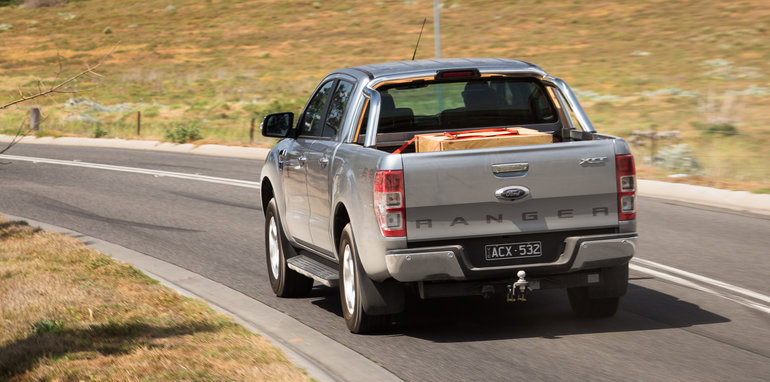
The Navara bounced over bumps, and you could feel the limit of the clever rear suspension over larger compressions. It couldn’t control the load imbalance, and as such it felt as though the rear was steering the front. Not a comfortable experience at all.
The Triton also struggled with its tray full, wandering and wobbling over bumps and with indecisive steering that was at first too quick to respond and then slow and heavy to correct. It was also pushed around by the wind more than any other ute.
The trays themselves offer plenty to discuss, and being the businessman among us, Andrew made some pertinent observations about the business ends of these eight trucks.
Firstly, all utes had four tie-down anchor-points in the tray which varied in positioning, but the Navara’s excellent Utili-Track system offered enhanced load holding capability. That system allows you to manoeuvre the cast steel, rail-held detents to wherever you need them. He found the D-Max’s “solidly mounted†load hitches, which had the front tie-downs at the front of the tray rather than on the sides, meant fore/aft movement under acceleration should be more limited.
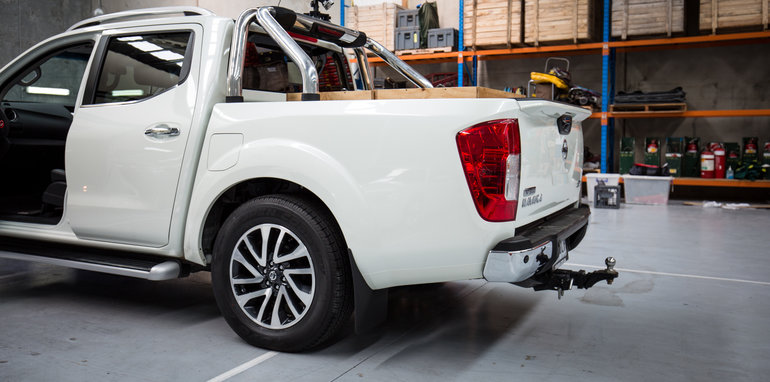
The Navara is also the only ute in this segment with a sliding rear window for loading items through if needed, and Andrew thought the flat-top tailgate, while looking sort of like a rear spoiler, was great for perching your backside on â€" but it also provides paint protection when loading longer items such as timber.
The Nissan also had a waterproof 12-volt plug, and the Ford and Volkswagen also had high-mounted 12V outlets in their trays. The rest missed out.
The tailgate of the Ford also includes a few cup holders for picnics or smoko breaks, and a pair of bottle-holsters up top, too, and it and the VW both have rear cargo bay lights to help you see what you’re doing in the dark.
Being an engineer by trade, Andrew thought the attention to detail of the Amarok’s concealed counterbalanced tailgate spring system â€" which means the amount of work required to open and close the tailgate seems less â€" was “cleverâ€.
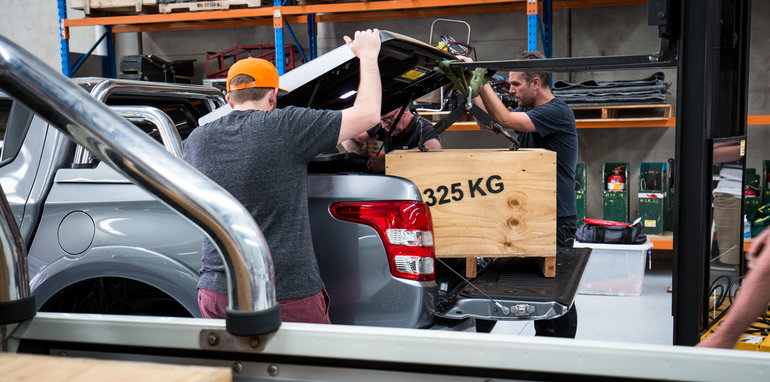
At the other end of the scale, the Triton’s tailgate was found to be heavy.
The Colorado’s plastic-riddled rear end â€" which is clearly aimed more at posing than purpose â€" proving a bit pointless, but that sliding tonneau cover would be great if it wasn’t so brittle. Holden says it is looking into the problem.
In terms of towing, the Amarok drops from first to last. It has the lowest braked towing capacity of all of these utes, with 3.0 tonnes of capacity. All vehicles on test have an unbraked towing capacity of 750kg.
The next worst on paper is the Triton, with a 3.1-tonne capacity, then the HiLux with its 3.2 tonnes. All the rest have the maximum 3.5-tonne ability.
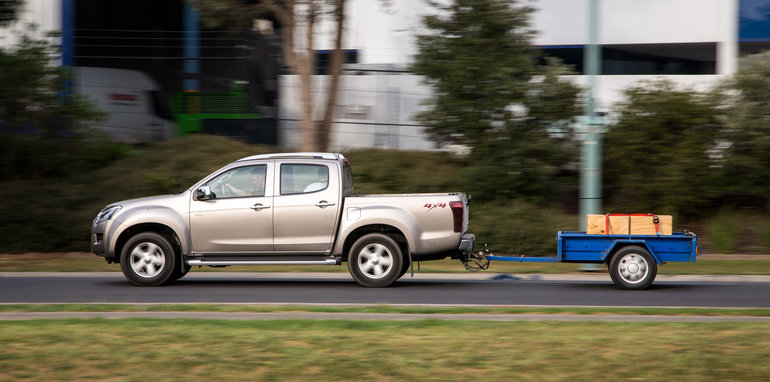
When it came to actual towing, we loaded up a box trailer so it was a total 750kg maximum, and put an extra pair of bodies in the back seat to simulate a family holiday load. The extra weight of our bulky testers over a pair of kids must compensate for a lack of luggage in the tray.
The load behind was dealt with effectively by the D-Max, which was said to show “no issue whatsoever, hardly even noticeableâ€, and the Ranger, which was found to “not feel it at all†and had “minimal impact on brakingâ€. The BT-50 was also strong, as was the Triton, though its brake pedal felt a bit wooden.
The Amarok was decent in this regard, but not in the top four. The nature of its drivetrain is that the transmission will row through the gears to get the most out of the engine, but it lacked the urge and ease of the bigger capacity engines.
Holden’s dual-cab followed up with another average showing. The Colorado’s engine was loud, the ride remained unsettled, and the brake pedal felt squishy and slow to react underfoot.
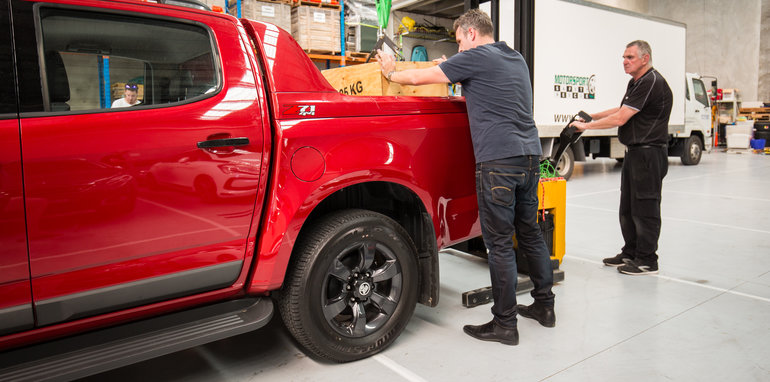
The HiLux we had felt a little loose when it came to towing, and upon inspection the towbar was wobbling somewhat. You could feel the trailer tugging at the tow ball.
Interior
The cabin, the office, the workplace, the family room â€" those are four names you could give to the interior of a dual-cab ute.
As such, it’s important that the cockpit lives up to expectations on all fronts. It needs good storage for odds and ends, it needs good comfort for family trips, and it needs good safety measures to keep its occupants at ease.
But there’s one ute here that can’t do that. The Volkswagen Amarok.
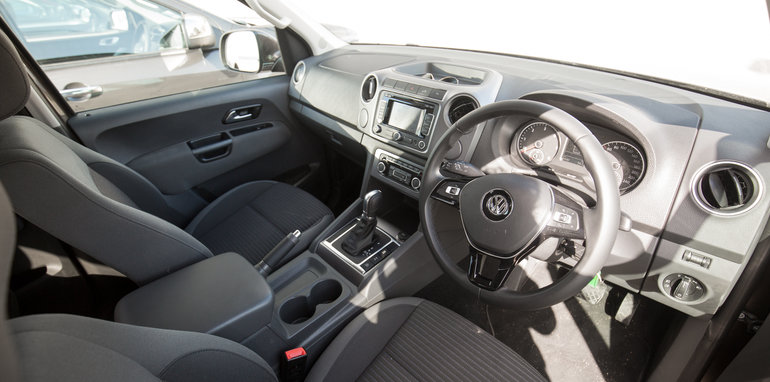
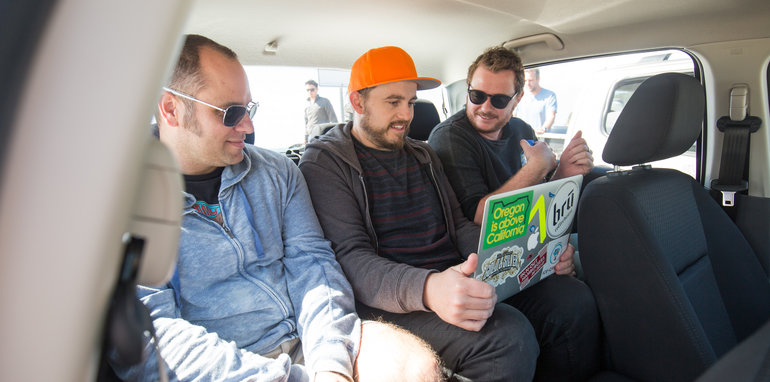
This was one of the major discussion points of this mega-test: should the Amarok be penalised for lacking rear-seat airbag protection, where every other dual-cab ute now has full-length curtain airbags as standard?
And all of us agreed that it’s a problem. Given the fact that the market has moved on so much in such a short time, it is hard to fathom that the Amarok is not available â€" ANYWHERE â€" with rear airbag protection. It wasn’t engineered to have it.
That hasn’t stopped the Amarok from achieving the highest possible safety rating from crash test authorities. So whether or not you rule it out of your consideration set will depend on whether you, personally, think that’s a vital inclusion or not.
So, the Amarok has four airbags (dual front, front side), while the remainder add side curtain airbags (total: six), and the HiLux and Triton also have driver’s knee airbags (total: seven).
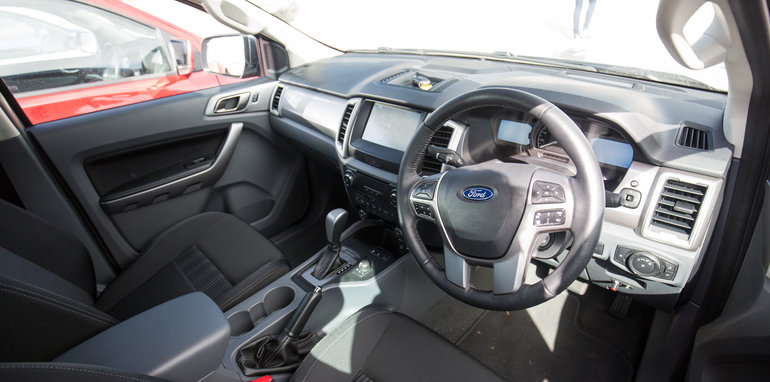
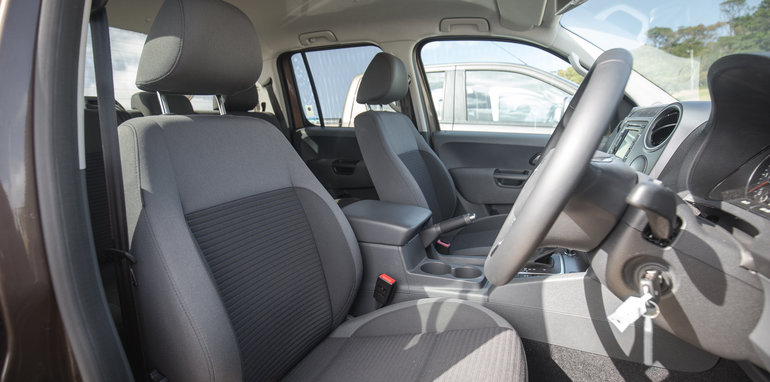
Pictured above: Ford Ranger (top); Volkswagen Amarok (bottom)
As judges, we were split: I’d buy one, because I don’t have kids; Trent would, too; Curt wouldn’t (father of three); and Mike wouldn’t, but that’s more of a personal stance on safety than any aspirations to become a dad any time soon.
That aside â€" and this is why it’s such a big deal â€" the Amarok is hands-down the best in terms of interior space.
With the three biggest judges â€" me, Mike and Trent â€" sat alongside one another on the back bench, all of us felt like we could tolerate the space for a lot longer than any of the other utes here. The big, squared-off windows allow good outward vision, the shoulder, head and knee room is excellent, and the middle passenger has space for their feet.
The Amarok measures 1954mm wide, where the next broadest is the Colorado at 1882mm. At the other end of the scale the Mitsubishi spans just 1815mm across.
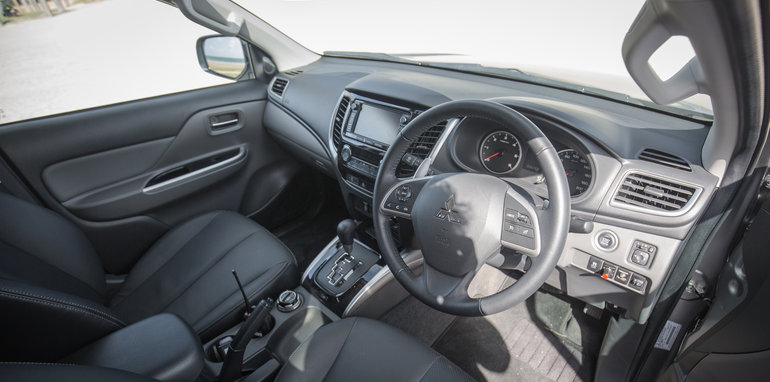
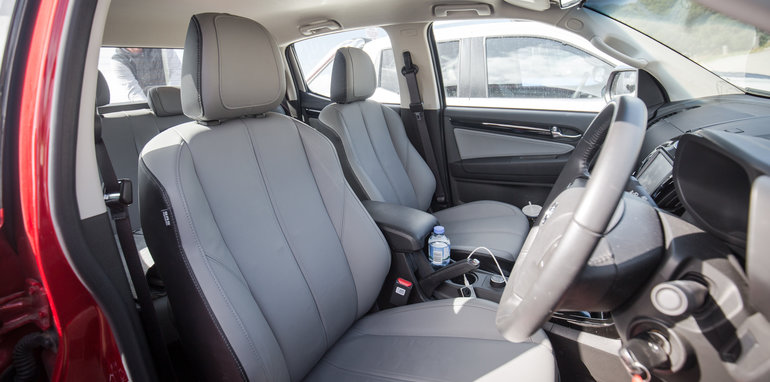
Pictured above: Mitsubishi Triton (top); Holden Colorado (bottom)
It’s no surprise, then, that the Colorado runs a (distant) second for rear-seat space. It was found to offer a flatter bench than the rest of the competitors, allowing extra hip and bum room, while shoulder space was also decent.
The D-Max was close, as where the Ranger and BT-50. These utes all coped with three burly blokes across the back, but Mike, Trent and myself all found that anything more than an hour of travel time would be a chore.
The Navara was just behind, but it made up for a lack of headroom (due to the silly sunroof) with rear seat air-vents, and it was the only ute here with those passenger-friendly ventilators.
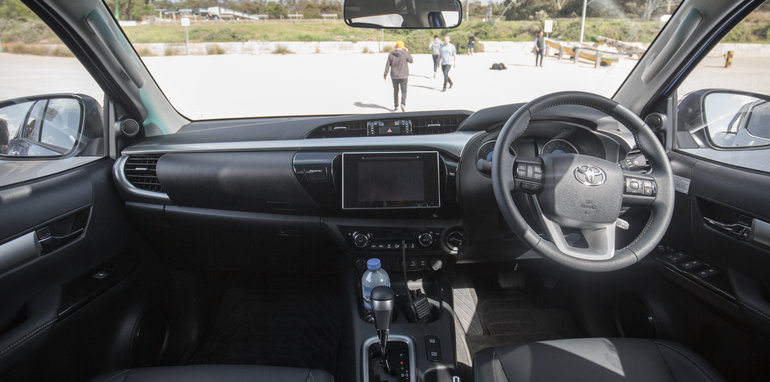
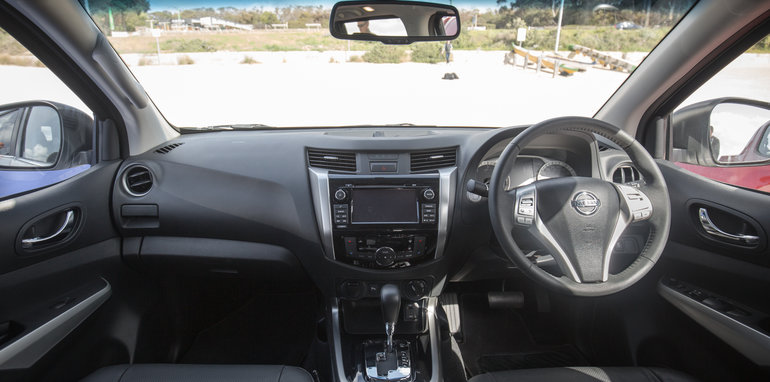
Pictured above: Toyota HiLux (top); Nissan Navara (bottom)
The worst on test for three-abreast was the HiLux. The new model has some extra space compared to its predecessor, and it certainly feels acceptable as a four-seater, but with five on board it was just uncomfortable, particularly for knee-room, middle-seat foot-room, and shoulder space.
This was a big deal, and Trent put it succinctly: “given this is the newest, it should be way better in the backâ€. Mike â€" being tall â€" was also annoyed at the hard-set grab handles for outboard passengers, which he could almost rest his forehead on. Imagine that in the event of an accident… “I cannot point out how bad that is,†Mike said.
It wasn’t all bad for the HiLux, though. Its interior presentation was considered to be among the top three, with Trent suggesting it was a close second to the SUV-like Navara for appearance.
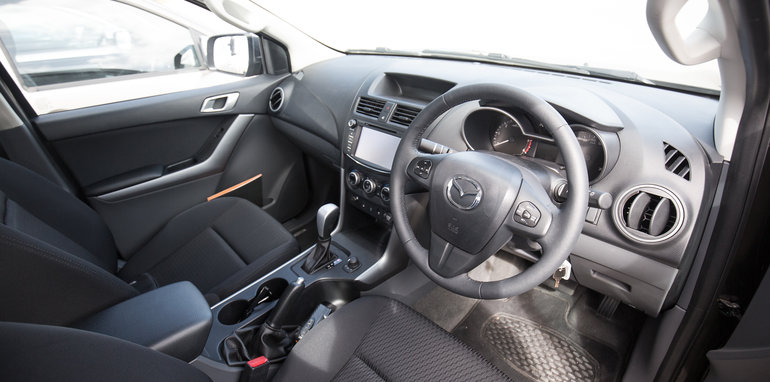
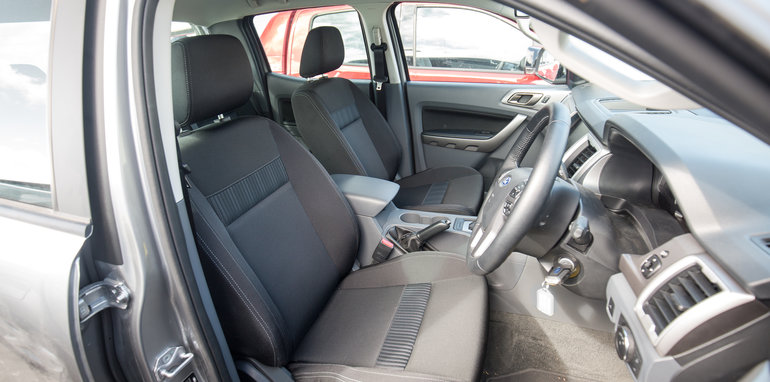
Pictured above: Mazda BT-50 (top); Ford Ranger (bottom)
Mike said that he thought the Navara “felt more premium, for sure, more like a passenger car†â€" yet he said that made the oversight of not having ISOFIX “more grievousâ€.
The Amarok was third for perceived presentation.
As you may also expect, the Triton’s narrow cabin meant it felt tight across the back â€" even lacking shoulder room when compared to the Toyota â€" but it had better leg- and toe-room than the HiLux. Its middle seat was the most uncomfortable, too, due to a flip-down cupholder with such poor finish that it didn’t shut completely.
There were a few shockers for fit and finish. The Ford had a couple of mismatched plastic gaps on the dash; the D-Max and Colorado had horrible dash-top storage caddies that only opened if you hit the button just so; while the Colorado also had a head-lining that was barely fitted.
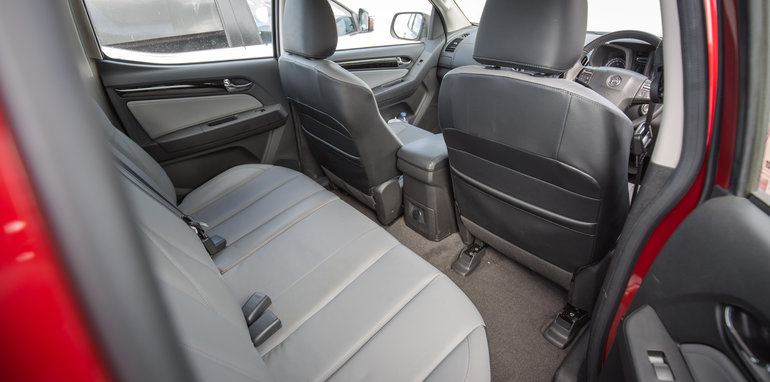
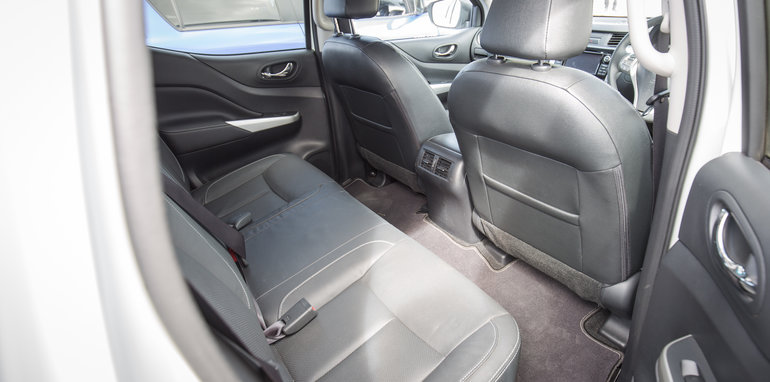
Pictured above: Holden Colorado (top); Nissan Navara (bottom)
The Triton’s multiple tones of grey plastic may not appeal too much, but it was considered a good interior given that it was the most affordable vehicle on test, but it certainly didn’t feel the cheapest inside.
For those with small children, the Amarok, HiLux, Ranger and Triton have ISOFIX anchor points for the outboard rear seats.
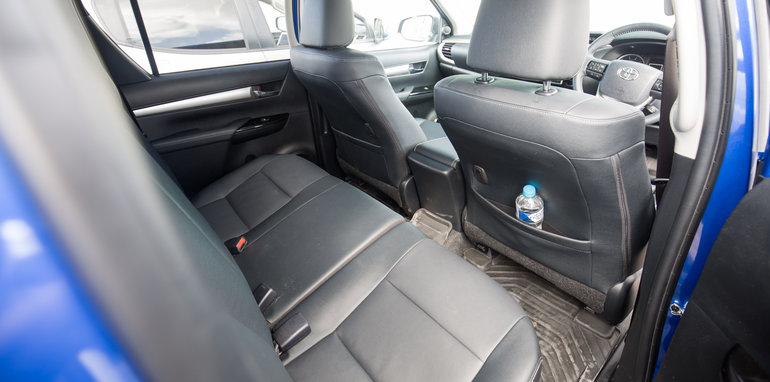
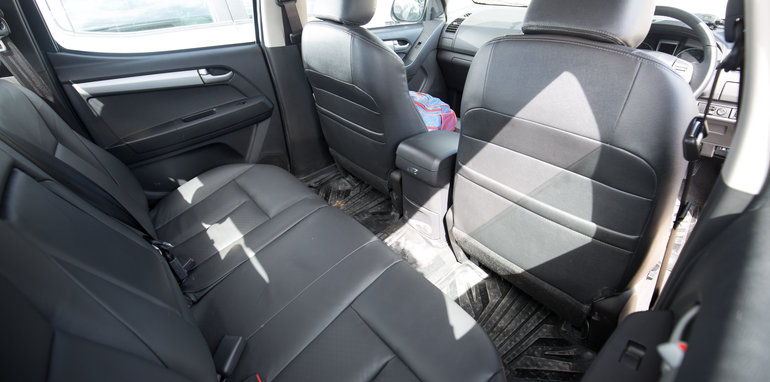
Pictured above: Toyota HiLux (top); Isuzu D-Max (bottom)
Storage is important for family vehicles and work trucks alike, and while map pockets aren’t likely to be used for maps any more, they offer good seat back storage for toys, treats or tools. The Amarok has none, though, while the BT-50 and Triton have one each, and the rest have two. The HiLux even has a pair of hooks for shopping bags.
All the utes had door pockets front and rear which were big enough to hold at least a 600mL bottle (rear) and a bottle and some paperwork (front), but the VW’s flocked pockets were exceptional (though Mike raised a good point about pie crumbs and dog hairs; Trent countered by saying he’d prefer to vacuum them out than to have bottles and stuff rattling around in the doors).
And while a few of these trucks had “leather†trim, the Ranger’s cloth finish felt more premium and was finished more convincingly, so much so that Trent and I came to the conclusion that “good fabric trim better than cheap leather†(a direct reference to the Colorado and, to a lesser extent, the D-Max). Curt countered that “be it kids’ chocolate or worksite grease, leather trim is easier to clean and maintain than fabric.†The Ranger added another plus to its list with its 230V plug in the rear centre console, which allows you to charge things like power tools, laptops and phones quickly.
Verdict
What an epic test this was.
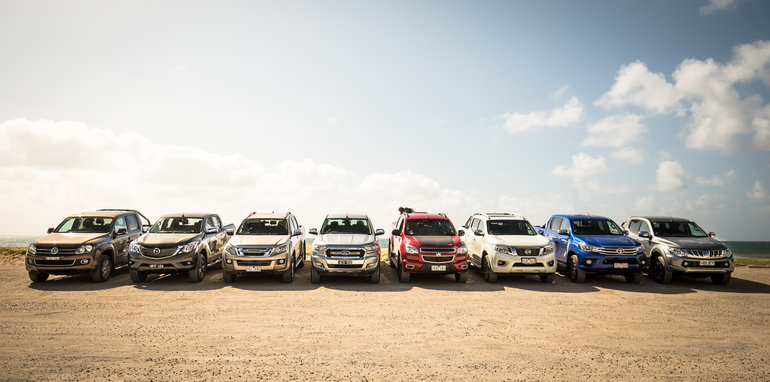
With five criteria (plus the judges’ picks!) to meet, there were always going to be some utes that stood out more than others. And remember that we weren’t assessing these as hard-core tools of the trade, more as a mix of lifestyle and workhorse.
And to be perfectly honest, none of these utes completely nails every single aspect of our criteria â€" but the Ford Ranger turned out to be the best of this bunch, narrowly edging out the Volkswagen Amarok, mainly due to that question over rear airbag coverage.
The Mazda BT-50 ran third, with the Nissan Navara just behind it. The Toyota HiLux â€" a huge improvement over its predecessor â€" didn’t crack the top half in this test, ranking fifth overall ahead of the tough-as-guts-but-too-expensive Isuzu D-Max, which itself only just pipped the value-packed Mitsubishi Triton. In last spot was the Holden Colorado, which was considered overpriced and underwhelming in equal measure.
See below our breakdown of the scoring for this test, and tell us in the comments section below whether you agree with our judgement.
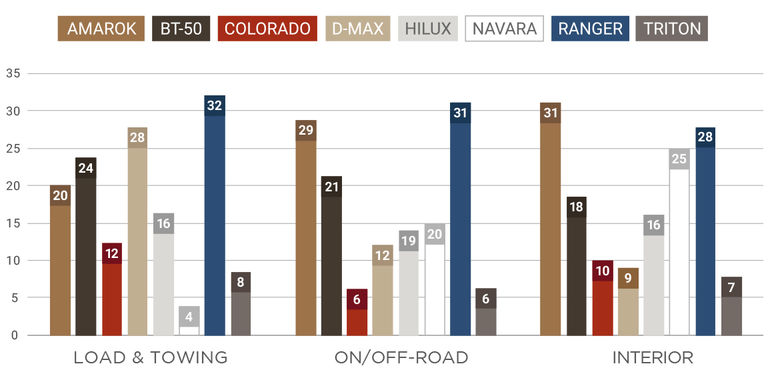
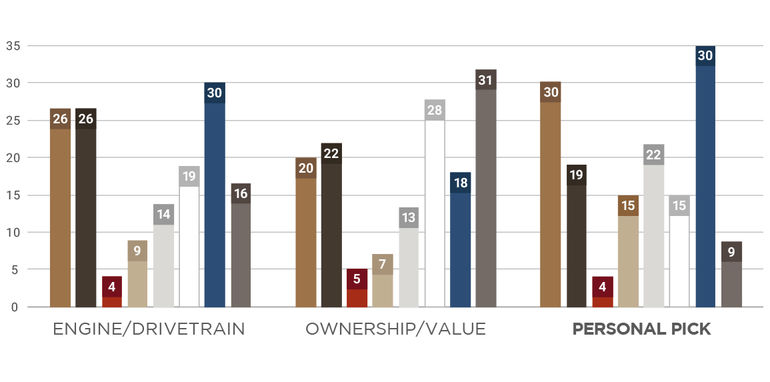
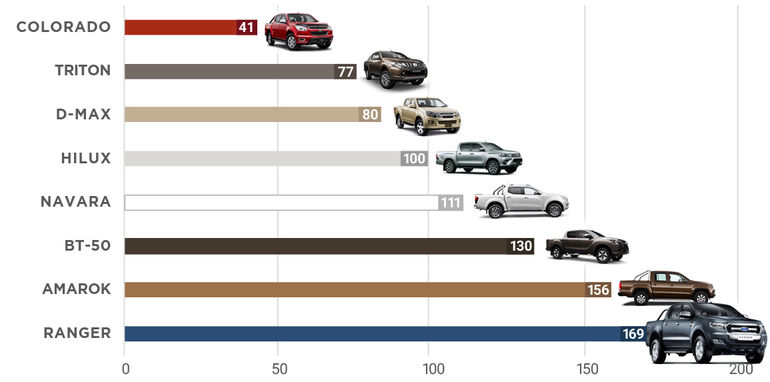
Click on the Photos tab for more images by Tom Fraser.
Comments
Post a Comment